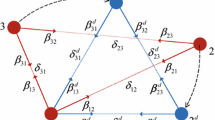Abstract
The availability of additional force cues in haptic devices are often expected to improve control performance, over conditions that only provide visual feedback. However, there is little empirical evidence to show this to be true for the teleoperation control of remote vehicles [i.e., multiple unmanned aerial vehicles (UAVs)]. In this paper, the contribution of haptic force feedback cues to the teleoperation of multiple UAVs was evaluated. These cues were based on either the UAVs’ velocity or directed forces from sensed obstacles. Both induced improved teleoperator perception of the remote environment. However, velocity-based cues resulted in more effortful maneuvering.





Similar content being viewed by others
References
Borenstein J, Koren Y (1990) Teleautonomous guidance for mobile robots. IEEE Trans Syst Man Cybern 20(6):1437–1443
Diolaiti N, Melchiorri C (2002) Teleoperation of a mobile robot through haptic feedback. In: Proceedings of the international workshop on haptic virtual environments and their applications, pp 67–72
McCarley J, Wickens C (2005) Human factors implications of UAVs in the national airspace. Aviation Human Factors Division, Savoy, Illinois, Technical report AHFD-05-05/FAA-05-01
Franchi A, Masone C, Grabe V, Ryll M, Bülthoff HH, Giordano PR (2012) Modeling and control of UAV bearing formations with bilateral high-level steering. Int J Robot Res 31(12):1504–1525
Franchi A, Secchi C, Ryll M, Bülthoff HH, Giordano PR (2012) Shared control: balancing autonomy and human assistance with a group of quadrotor UAVs. IEEE Robot Autom Mag 19(3):57–68
Hong A, Bülthoff HH, Son HI (2013) A visual and force feedback for multi-robot teleoperation in outdoor environments: a preliminary result. In: 2013 IEEE international conference on robotics and automation (ICRA). IEEE, pp 1471–1478 (2013)
Hong A, Lee DG, Bülthoff HH, Son HI (2017) Multimodal feedback for teleoperation of multiple mobile robots in an outdoor environment. J Multimodal User Interfaces 11(1):67–80
Bahrick H (1957) An analysis of stimulus variables influencing the proprioceptive control of movements. Psychol Rev 64(5):324–328
Hill J (1979) Study of modeling and evaluation of remote manipulation tasks with force feedback. Final Report, SRI International Project, vol 7696
Hokayem P, Spong M (2006) Bilateral teleoperation: an historical survey. Automatica 42(12):2035–2057
van der Meijden O, Schijven M (2009) The value of haptic feedback in conventional and robot-assisted minimal invasive surgery and virtual reality training: a current review. Surg Endosc 23(6):1180–1190
Wagner C, Howe R, Stylopoulos N (2002) The role of force feedback in surgery: analysis of blunt dissection. In: Proceedings of the symposium on haptic interfaces for virtual environment and teleoperator systems, pp 73–79 (2002)
Reiley C, Akinbiyi T, Burschka D, Chang D, Okamura A, Yuh D (2008) Effects of visual force feedback on robot-assisted surgical task performance. J Thorac Cardiovasc Surg 135(1):196–202
Wagner C, Howe R (2007) Force feedback benefit depends on experience in multiple degree of freedom robotic surgery task. IEEE Trans Robot 23(6):1235–1240
Anderson R, Spong M (1989) Bilateral control of teleoperators with time delay. IEEE Trans Autom Control 34(5):494–501
Massimino M (1995) Improved force perception through sensory substitution. Control Eng Pract 3(2):215–222
Yoon J, Ryu J (2001) Design, fabrication, and evaluation of a new haptic device using a parallel mechanism. IEEE/ASME Trans Mechatron 6(3):221–233
Hayward V, MacLean K (2007) Do it yourself haptics: part I. IEEE Robot Autom Mag 14(4):88–104
Murray R (2007) Recent research in cooperative control of multivehicle systems. J Dyn Syst Meas Control 129:571–583
Franchi A, Secchi C, Son HI, Bülthoff HH, Giordano PR (2012) Bilateral teleoperation of groups of mobile robots with time-varying topology. IEEE Trans Robot 28(5):1019–1033
Lee D, Franchi A, Son HI, Ha C, Bülthoff HH, Giordano PR (2013) Semiautonomous haptic teleoperation control architecture of multiple unmanned aerial vehicles. IEEE/ASME Trans Mechatron 18(4):1334–1345
Ju C, Son HI (2018) Multiple UAV systems for agricultural applications: control, implementation, and evaluation. Electronics 7(9):162
Lam T, Boschloo H, Mulder M, Van Paassen M (2009) Artificial force field for haptic feedback in UAV teleoperation. IEEE Trans Syst Man Cybern Syst Hum 39(6):1316–1330
Son HI, Franchi A, Chuang LL, Kim J, Bülthoff HH, Giordano PR (2013) Human-centered design and evaluation of haptic cueing for teleoperation of multiple mobile robots. IEEE Trans Cybern 43(2):597–609
Son HI, Chuang L, Kim J, Bülthoff HH (2011) Haptic feedback cues can improve human perceptual awareness in multi-robots teleoperation. In: Proceedings of the international conference on control, automation and systems, pp 1323–1328
Lee D, Huang K (2010) Passive-set-position-modulation framework for interactive robotic systems. IEEE Trans Robot 26(2):354–369
Hashtrudi-Zaad K, Salcudean SE (2001) Analysis of control architectures for teleoperation systems with impedance/admittance master and slave manipulators. Int J Robot Res 20(6):419–445
Wichmann FA, Hill NJ (2001) The psychometric function: I. Fitting, sampling and goodness-of-fit. Percept Psychophys 63(8):1293–1313
Acknowledgements
This research was supported in part by the Basic Science Research Program through the National Research Foundation of Korea (NRF) funded by the Ministry of Science, ICT & Future Planning under Grant NRF-2018R1D1A1B07046948, and in part by Korea Institute of Planning and Evaluation for Technology in Food, Agriculture, Forestry (IPET) through Advanced Production Technology Development Program, funded by Ministry of Agriculture, Food and Rural Affairs (MAFRA) (115062-2).
Author information
Authors and Affiliations
Corresponding author
Additional information
Publisher's Note
Springer Nature remains neutral with regard to jurisdictional claims in published maps and institutional affiliations.
Rights and permissions
About this article
Cite this article
Son, H.I. The contribution of force feedback to human performance in the teleoperation of multiple unmanned aerial vehicles. J Multimodal User Interfaces 13, 335–342 (2019). https://doi.org/10.1007/s12193-019-00292-0
Received:
Accepted:
Published:
Issue Date:
DOI: https://doi.org/10.1007/s12193-019-00292-0



